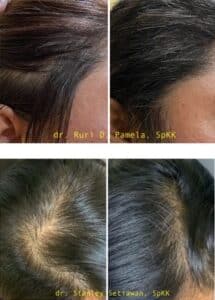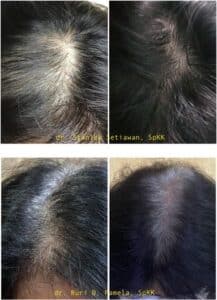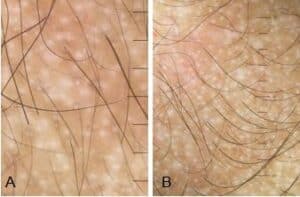Ruri D Pamela1*, Stanley Setiawan2
1Department of Dermatology and Venereology, Dr. Suyoto Hospital Centre of Rehabilitation, Jakarta, Indonesia
2C Derma Dermatology and Aesthetic Clinic, Jakarta, Indonesia
*Corresponding Author: Ruri D Pamela, Department of Dermatology and Venereology, Dr. Suyoto Hospital Centre of Rehabilitation, Jakarta, Indonesia; E-mail: [email protected]
Published Date: 17-12-2022
Copyright© 2022 by Pamela RD, et al. All rights reserved. This is an open access article distributed under the terms of the Creative Commons Attribution License, which permits unrestricted use, distribution, and reproduction in any medium, provided the original author and source are credited.
Abstract
Background: Platelet Rich Plasma (PRP) is an autologous concentration of human platelets contained in a small volume of plasma, has been proposed as a potential adjuvant therapy to Female Pattern Hair Loss (FPHL). Despite the widespread use of PRP in numerous fields of medicine, there have been few studies that investigated the clinical efficacy of PRP in FPHL.
Methods: Fourteen female patients, age ranged from 20-45 years, diagnosed with female pattern hair loss were enrolled in this single-blinded randomized placebo-controlled study. Fourteen patients were divided randomly into two groups: Group 1 were injected with PRP using insulin syringe and group 2 were injected with normal saline as placebo. All patients were followed at 3 and 6 months after the last treatment sessions. Of the total subjects enrolled, on ten subjects completed the study. In total, 7 (70%) individuals received PRP and 3 (30%) received placebo. During all the treatment sessions, there were no severe adverse events reported. The study yielded investigator, subject and photographic assessments.
Results: On the basis of the independent-blinded investigator assessment of change in the patient’s scalp hair growth from baseline, treatment in PRP group demonstrated as scale 1 improvement in 5 subjects (26-50%) and scale 2 improvement in 2 subjects (51-75%) at the final visit as compared to baseline (Fig. 1,2). In contrast, in the placebo group were rated as scale 0 improvement (0-25%).
Conclusion: PRP injection for FPHL is a simple, cost-effective and feasible treatment option with good safety profile. However more randomized and multicentric trials with a large number of patients will be required to prove the validity of these results, to obtain these answers and to get more robust statistical results.
Keywords
Pattern Hair Loss; Platelet-Rich Plasma; Human Platelets; Headache
Background and Objective
Female Pattern Hair Loss (FPHL) is the most common form of alopecia in women [1,2]. It is a common cause of non-scarring alopecia in women, affecting approximately 40% of women by age 50 [3]. Affected women may experience psychological distress and impaired social functioning [4]. Recently, Platelet-Rich Plasma (PRP) injection has been proposed as a potential adjuvant therapy to treat androgenetic alopecia [5].
Platelet-rich plasma is an autologous concentration of human platelets contained in a small volume of plasma [6]. Platelets can be likened to cell reservoirs that produce, store and release numerous growth factors capable of stimulating the proliferation of stem cells and the replication of mesenchymal cells, fibroblasts, osteoblasts and endothelial cells [7]. Despite the widespread use of PRP in numerous fields of medicine, there have been few studies that investigated the clinical efficacy of PRP in FPHL. The purpose of this study is to evaluate the therapeutic potential of PRP in FPHL [4,8].
Patients and Methods
Our case study was designed as a single-blinded randomized placebo-controlled trial. Fourteen female patients, diagnosed with female pattern hair loss were enrolled in the study. Their age ranged from 20 to 45 years. Diagnosis of FPHL was made in all patients by board-certified Dermatologist before treatment, based on a detailed medical history (any drugs causing hair loss), family history and clinical examination. Patients, who had received topical or systemic treatments for hair loss in the previous 3 months, were excluded. Patients who are pregnant or those with a present history of keloids, malignancies, bleeding disorders and thyroid dysfunction were also excluded. Written and signed informed explanatory consent were obtained from all the patients before enrolment.
Fourteen patients were divided randomly into two groups: Group 1 were injected with PRP using insulin syringe and group 2 were injected with normal saline as placebo. PRP were prepared by a single centrifugation from the patient’s own blood.
PRP kit used in this study was T-Lab® (T-biyoteknoloji Ltd, Bursa, Turkey). We used the single-spin protocol for preparing PRP. About 10 ml of blood was drawn from the patient’s antecubital vein and inserted into 10 ml vacutainer tubes that contain trisodium citrate. These tube was placed in a centrifuge (T-Lab centrifuge 106, T-biyoteknoloji Ltd, Bursa, Turkey) and spun at 2300 Rotation Per Minute (RPM) for 8 minutes and 1 ml of PRP were harvested from each tubes.
PRP were injected every 4 weeks for 3 treatment sessions (3 months). All patients were followed at 3 and 6 months after the last treatment sessions. The serial conventional photographic examination taken every months during treatment sessions. Clinical outcomes were assessed for pre and post comparison. Additionally, subjects’ satisfaction for the change in hair growth and overall improvement was also evaluated using a 5-rating score. The patients 5-score rating score as follows; 1= very dissatisfied, 2= not very satisfied, 3= slightly satisfied, 4= satisfied, 5= very satisfied. Physicians’ satisfaction scores to compare before and after treatment by photographs be determined by an independent-blinded investigator using a clinical quartile rating scale. The quartile rating scale is as follows: 0= 0-25% improvement, 1= 26-50% improvement, 2= 51-75% improvement and 3= 75% improvement. Adverse effects such as headache, post injection bleeding, bruise, secondary infection or allergic/ irritation condition also are determined.
Results and Discussion
Of the total subjects enrolled, on ten subjects completed the study. In total, 7 (70%) individuals received PRP and 3 (30%) received placebo. During all the treatment sessions, there were no severe adverse events reported. The study yielded investigator, subject and photographic assessments. The key assessment was based on the standardized conventional photographs that were evaluated by an independent-blinded investigator for assessment of improvement in hair fullness and hair growth. On the basis of the independent-blinded investigator assessment of change in the patient’s scalp hair growth from baseline, treatment in PRP group demonstrated as scale 1 improvement in 5 subjects (26-50%) and scale 2 improvement in 2 subjects (51-75%) at the final visit as compared to baseline (Fig. 1,2). In contrast, in the placebo group were rated as scale 0 improvement (0-25%).
The most commonly reported side effect was mild headache, occurring in 20% of PRP and placebo subjects. Other adverse events occurring only in were swelling (10%) in PRP subjects, redness/ bruise (20%) in PRP and placebo subjects and post-injection bleeding (30%) in PRP and placebo subjects. All side effects were mild and resolved without intervention within 24 hours.
PRP is a product of the whole blood that has a high concentration of platelets. It contains a number of different growth factors and other cytokines that are released through degranulation and stimulate healing of hard and soft tissues [6]. PRP contains numerous growth factors to regulate cell proliferation, differentiation, angiogenesis and chemotaxis. The growth factors contained in alpha granules and dense granules of the platelets. The Platelet Derived Growth Factors (PDGFaa, PDGFbb and PDGFab), Transforming Growth Factor Beta (TGFβ1 and 2), Epithelial Growth Factor (EGF) and Vascular Endothelial Growth Factor (VEGF) are alpha granules growth factors [7,8].
Our PRP results were supported by what Tawfik, et al., has found [9]. They conducted a randomized and placebo-controlled study to compare hair density and hair thickness with PRP versus placebo using folliscope. Clinical improvement in hair volume and quality together with a high overall patient satisfaction in PRP-injected sites were maintained during the 6-month follow-up after the end of last session.
The limitations of our study were the small number of cases in each group and the short duration of the study. In addition, none of our participants volunteered to undergo a skin biopsy to compare the microscopic effects of PRP versus placebo (Fig. 1-3).

Figure 1: Baseline clinical scalp photograph of a representative subject 3 months post the last injection of PRP demonstrating scale 1 improvement (26-50%) in global photographic assessment.

Figure 2: Baseline clinical scalp photograph of a representative subject 3 months post the last injection of PRP demonstrating scale 2 improvement (51-70%) in global photographic assessment.

Figure 3: [A] Baseline of dermoscopic examination of the scalp and [B] 3 months post the last injection of PRP.
Conclusion
The findings of this case study suggest that PRP appears as a safe alternative option for patients affected by female pattern hair loss or androgenetic alopecia, but more randomized and multicentric trials with a large number of patients will be required to prove the validity of these results, to obtain these answers and to get more robust statistical results. Research is also underway to identify combination of PRP with other modalities/ agents that may offer useful activity against female pattern hair loss.
Funding
This study was funded by Redo Marketing Indonesia Corp. Dr. Pamela and Dr. Setiawan has received grant from Redo Marketing Indonesia Corp.
Conflict of Interest
The authors declare that they have no conflict of interest.
References
- Birch MP, Lalla SC, Messenger AG. Female pattern hair loss. Clin Dermatol. 2002;27(5):383-8.
- Dinh QQ, Sinclair R. Female pattern hair loss: current treatment concepts. Clinical interventions in aging. 2007;2(2):189.
- Mercuri SR, Paolino G, Di Nicola MR, Vollono L. Investigating the safety and efficacy of platelet-rich plasma (PRP) treatment for female androgenetic alopecia: Review of the literature. Medicina. 2021;57(4):311.
- Dubin DP, Lin MJ, Leight HM, Farberg AS, Torbeck RL, Burton WB, et al. The effect of platelet-rich plasma on female androgenetic alopecia: a randomized controlled trial. J Am Acad Dermatol. 2020;83(5):1294-7.
- Starace M, Alessandrini A, D’Acunto C, Melandri D, Bruni F, Patrizi A, et al. Platelet‐rich plasma on female androgenetic alopecia: Tested on 10 patients. J Cosmetic Dermatol. 2019;18(1):59-64.
- Amini F, Abiri F, Ramasamy TS, Sing Tan ES. Efficacy of Platelet Rich Plasma (PRP) on skin rejuvenation: A systematic review. Iranian J Dermatol. 2015;18(3):119-27.
- Ayatollahi A, Hosseini H, Gholami J, Mirminachi B, Firooz F, Firooz A. Platelet rich plasma for treatment of non-scarring hair loss: systematic review of literature. J Dermatological Treatment. 2017;28(7):574-81.
- Gupta AK, Versteeg SG, Rapaport J, Hausauer AK, Shear NH, Piguet V. The efficacy of platelet-rich plasma in the field of hair restoration and facial aesthetics-a systematic review and meta-analysis. J Cutaneous Med Surg. 2019;23(2):185-203.
- Tawfik AA, Osman MA. The effect of autologous activated platelet‐rich plasma injection on female pattern hair loss: A randomized placebo‐controlled study. J Cosmetic Dermatol. 2018;17(1):47-53.
Article Type
Case Report
Publication History
Received Date: 07-11-2022
Accepted Date: 11-12-2022
Published Date: 17-12-2022
Copyright© 2022 by Pamela RD, et al. All rights reserved. This is an open access article distributed under the terms of the Creative Commons Attribution License, which permits unrestricted use, distribution, and reproduction in any medium, provided the original author and source are credited.
Citation: Pamela RD, et al. Evaluation of Platelet Rich Plasma for Treatment of Female Pattern Hair Loss: A Placebo-Controlled Case Study. J Dermatol Res. 2022;3(3):1-6.

Figure 1: Baseline clinical scalp photograph of a representative subject 3 months post the last injection of PRP demonstrating scale 1 improvement (26-50%) in global photographic assessment.

Figure 2: Baseline clinical scalp photograph of a representative subject 3 months post the last injection of PRP demonstrating scale 2 improvement (51-70%) in global photographic assessment.

Figure 3: [A] Baseline of dermoscopic examination of the scalp and [B] 3 months post the last injection of PRP.


